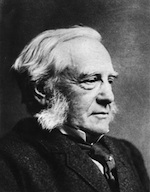I. Introduction: What is Henotheism?

Max Müller

Friedrich Schelling
Polytheism and monotheism are frequently regarded (along with agnosticism and atheism) as the principal forms of religious belief. Henotheism (the term derives from a Greek phrase meaning “one god” but implies that the principal god exists in a context of other gods) actually describes better the practice that we find not only in ancient Egypt but also in ancient India, ancient Greece and ancient Rome. Even the Christian Trinity may be regarded as the worship of one God among several. So, by studying how henotheism works in a system such as the ancient Egyptian “religion” (better, “religions”), we gain a clearer understanding of how it is that many of the world’s religious systems, past and present, operate.
My imaginative work, the cosmological or universal epic, Sentence of the Gods, consists of 26 books grouped according to the first letters of their single-word titles in a progression through the days of the week, which in most cultures follows the pattern of seven gods, in my case: SOL, LUNA, ARES, HERMES, HERA, APHRODITE, EL. So it might be said that my work is henotheistic, since each of these seven gods dominates the other six while the books celebrating him or her are being read. It is a feature of traditional henotheism that the principal god periodically changes, as we move from one locale to another (even from one part of a single locale to another part), and through history the principal god also changes.
Wikipedia tells us that the term “henotheism” was coined by Friedrich Schelling (1775-1854) to depict the early stages of monotheism. Max Müller, another famous German scholar, “brought the term into common usage to describe the worship of a single god while accepting the existence of other deities. Müller,” Wiki continues, “made the term central to his criticism of western theological and religious exceptionalism (relative to eastern religions), focusing on a cultural dogma that held monotheism to be both better defined than and inherently superior to other, differing conceptions of God.” Given the havoc wreaked upon the world by Christians, Muslims and other monotheists, perhaps it is time to reevaluate polytheism.
Henotheism is a form of polytheism, though polytheism need not be henotheistic. Since so many great religions have been henotheistic we might do well to seek a broader, fuller definition and grasp of the phenomenon. Presently we will turn to ancient Egypt, but for the moment let us continue with terminology. Variations on the term “henotheism” are “inclusive monotheism” and “monarchical polytheism,” designed to differentiate two forms of the phenomenon. Related terms are “monolatrism” and “kathenotheism,” understood as sub-types of “henotheism.” (“Kathenotheism” means “one god at a time.”) Henotheism is similar to but less exclusive than monolatry, because a monolator worships only one god.
The henotheist, according to Wiki, “may worship any god in the pantheon, though he usually will worship only one throughout his life (barring some sort of conversion). In certain forms of henotheism the choice of the supreme deity may be determined by geographical, historical, cultural or political reasons.” These four determinants will influence our discussion of ancient Egyptian religion. “Henotheism,” Wiki continues, “is based on the belief that a god may take any form at any time and still have the same essential nature. One name for a god may be used when a particular aspect is being represented or worshiped, whereas a different name may be given or used in describing or worshiping a different aspect.”
Not all these definitions apply with equal exactitude to the practice of the ancient Egyptians, but all are useful in considering its parameters. So I will continue to cite other definitions that apply to other henotheistic systems. The Neo-Platonist philosopher Plotinus, Wiki tells us, “taught that above the gods of traditional belief was The One.” In contemporary Hinduism, again according to Wiki, of its three major sects, Shaivism, Vaishnavism and Shaktiism, each regards only one specific Indic deity as the principal object of worship, whereas all others “are considered merely as ‘sub-gods’ or manifestations of it.” Another Indian sect singles out “not one specific deity but a pentad of gods.” A renowned temple is dedicated to both Vishnu and Shiva.
The myriad deities, or Devas, in historical Vedic religion have a subordinate status in relation to the One Supreme God, a status that some have even tried to express by comparing it to that of western demigods or angels. Prakashanand Saraswati, in The True History and Religion of India, prefers the term “celestial gods.” The Rig-Veda is the basis for Max Müller’s description of henotheism as “a polytheistic tradition striving towards a formulation of The One (ekam) Divinity aimed at by the worship of different cosmic principles.” “From this mix of monism, monotheism and naturalist polytheism, Max Müller decided to name the early Vedic relation ‘henotheistic.’” Let us now turn to the question of Greek henotheism.
One of the features of ancient Greece that brought about its unification relatively early in antiquity was a pantheon of divinities. Decided upon, it synthesized practice from various locales in which one or another, or several, of the twelve gods had been worshiped. In all the ancient henotheistic systems geographical diversity usually explains the original options (though they may not have seemed “options” to residents of an individual locale). Just as Indic religion evolved from the worship of primitive divinities, such as Indra and Varuna, so early Greek religion emphasized divinities such as Ouranos and Ge, who were later relinquished or replaced by more anthropomorphic, if less mysterious and powerful, gods.
Roman religion shared with Greek religion its henotheistic framework. Though early Roman divinities included many specialized gods, certain gods came to primacy. New World Encyclopedia: “At the head of the earliest pantheon was the triad of Mars (originally the Greek god Ares), Quirinus and Jupiter (originally the Greek god Zeus). Quirinus is thought to have been the patron of the armed contingent in times of peace. Jupiter, however, was clearly given primacy over all the others as ruler of the gods and became the protector of the Romans in their military activities beyond the borders of their own community. Roman henotheism was upheld until Christianity superseded the native religions of the Roman Empire.”
We think of Jews, Christians and Muslims as monotheists. Islam, however, “arose from a polytheistic environment.” Some non-Trinitarian Christians, according to Wiki, “have also been labeled henotheistic.” Isis, Osiris and Horus, an Egyptian Trinity, has curious parallels with the Christian Maria, the Christ Child and the Resurrected King. “The Church of Jesus Christ of Latter-day Saints considers the members of the Christian Godhead as three distinct beings, or gods.” “Some readings of the Old Testament have included other gods as co-existing (Baal, for example), since its teachings do not deny other gods’ existence but instead teach not to worship them.” It is today’s synagogue that makes us regard Judaism as monotheistic.
The historical religions of ancient Israel and Judah (10th and 7th centuries B.C.), however, were henotheistic. (The Moabites worshiped the god Chemosh, the Edomites, Qaus, both of whom were part of the greater Canaanite pantheon, headed by the chief god El.) The Israelites were forbidden to worship other deities, but according to some Biblical scholars, they were not fully monotheistic before the Babylonian Captivity. Mark S. Smith calls this stage a form of “monolatry,” arguing that Yahweh gradually merged with El, that acceptance of the cult of Asherah was common in the period of the Judges. Even the First Commandment can be, and has been, read as henotheistic (“Thou shalt have no other gods before me”).
This commandment, the first of the Ten, does not affirm or deny the existence of other deities per se. Nevertheless, as recorded in the Tanakh (the “Old Testament” Bible), in defiance of the Torah’s teachings, the patron god YHWH was frequently worshiped in conjunction with other gods such as Baal, Asherah and El. “Over time, this tribal god may have assumed all the appellations of the other gods in the eyes of the people.” There are also apparent elements of polytheism in other Biblical books. Moreover, even the word for God, “Elohim,” in Hebrew, is a plural, meaning “powerful ones” or “rulers.” Some consider that it is in Exodus 3:13-15 that YHWH first tells Moses that he is the same god as El, the Supreme Being.
The pre-Islamic Arabs (whose religion Islam rejected and undertook to rectify) were henotheists. The Qur’anic term for their religious doctrine is shirk (“sharing”); it describes them as mushrikin (those who believe in God but “share” other gods in divinity). Pre-Islamic Arabs believed in a supreme god, and the name that they used for him (“Allah”) is the same name used in Islam today. But they did believe in lesser gods as well. The univocal monotheism of Islam arose as a reaction to this belief system. Islam, however, still teaches a belief in angels, most prominently Jibrail, Mikail, Israfil and Azril. There also exists the belief in jinns, spiritual beings who can influence humans, and who at rare times intervene in their lives.
Henotheism is related to monolatry, which is also the worship of one god among many. The difference between the two systems is that henotheism is the worship of one god, not precluding the existence of others who may also be worthy of praise, whereas monolatry is the worship of one god who alone is worthy of worship, though other gods may be known to exist. “Henotheism” is an important term of classification in religious scholarship, since it nuances forms of worship that might otherwise be classified as “monotheism” or “polytheism.” The concept behind the term helps us to understand ancient religious and mythological systems based on narratives that serve to bring one god into primacy among other gods.